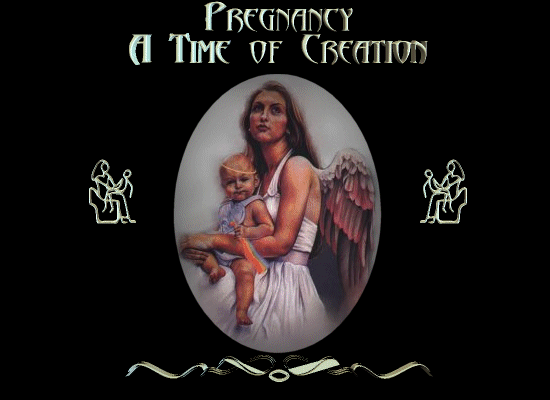
" Here under my heart you'll keep, till it's time
for us to meet, and we come apart that we may come together,
and you are born remembering the wavesound of my blood,
the thunder of my heart."
- Erica Jong
Pregnancy is a time of new life, transition, and family reconfiguration. Whether this is
your first pregnancy, or you've had several, each pregnancy is unique, rich with
growth and experience. Pregnancy is an event teeming with emotion and spiritual
searching. Expectant mothers often run a gamut of feelings, from joy to calmness, to doubt, ambivalence,
and fear. During this time, you will experience an amazing change in all aspects
of yourself - physically, mentally, emotionally, and spiritually.
Pregnancy normally lasts about nine calendar months, or ten lunar months, or 40 weeks, or 280 days from the beginning
of your last menstrual period. If a woman knows the date that she conceived, the
pregnancy will usually last 266 days from that date.

To calculate your EDC or
estimated date of confinement, use this formula:
- First day of Last menstrual period.......e.g. November 23rd
- Subtract 3 months from the above.........e.g.minus 3 months
- makes: August 23rd
- Add 7 days to the above date...............e.g. plus 7 days
- EDC is:....................................... August 30th
Pregnancy is usually discussed in terms of trimesters, each lasting three calendar
months. Each trimester routinely offers a unique focus, plus pregnancy-related
body sensations and changes. Psychological adjustments are also often different
in each trimester, offering challenge and the need for resolution by the expectant
woman and her significant others.
Highlights of each of the three trimesters are summarized in the following tables:
The First Trimester: Months 1 to 3 |
| Mother's Body |
Fetal Growth |
Mind & Emotions |
Tips for Coping |
2 - 5 lb. weight gain
No period
+ Pregnancy test
Urinary frequency
Morning sickness, nausea
Fatigue
Darker areola
Softer gums
Waist thickens
Breast
tenderness
Less sexual appetite
Low energy |
3 inches long
Weighs 1/2 ounce
Visible gender
All major systems developed
Sensitive to tetrogens-
medicines, alcohol,
infections, toxins
Face looks human
Sensitive to mother's
emotions and mental state
Responds to sound and music |
Acceptance of pregnancy
Emotional lability
Rapid mood
changes
More sensitive to others
Ambivalence
Worry about baby
Accept growing baby
into body image
Fears, fantasies,
anxieties |
Eat small, frequent meals
Eat dry crackers before
getting
up
Take naps
Get a good sleep
Reduce work load
Attend initial health visits
and prenatal classes
for nutrition and self-care
Relax, listen to soft music
Keep a
daily journal
Talk out your feelings
with friends and family |

The Second Trimester: Months 4 to 6 |
| Mother's Body |
Fetal Growth |
Mind & Emotions |
Tips for Coping |
1 lb. per week weight gain
First trimester
symptoms subside
Urinary frequency increases
Breast size increases
Less fatigue
Even darker areola
Softer gums, may bleed
Waist thickens more
Breast
tenderness
Renewed sexual appetite
Renewed energy
More vaginal discharge
Backaches
Constipation, Hemmorhoids
Enlarged abdomen
Blood Volume up 30%
Pelvic joints soften
More saliva
Perspire more
Facial flush |
10 - 12 inches long
Weighs 1.25 pounds
Face developed
Major glands form
Movement felt by mother -
Quickening at 20 weeks
Fetal heart beat
audible
Bones, blood, lungs
more mature
More sensitive to mother's
emotions and mental state
Responds to sound and music-
will move to rhythm |
Relaxing into pregnancy
Emotional lability
More positive mood changes
Still sensitive to others
Ambivalence may persist
More open with
feelings
More feelings of well-being
Body image changes
May dream
bizarre events
Feels need to learn
about baby's growth
Narcissitic, passive
May seem egocentric
|
Wear cotton underwear
Avoid pantyhose
No douching
Continue to take naps
Get a good sleep
Reduce work load
Attend regular health visits
Squat to lift
Wear low-heeled shoes
Sleep with pillow between
knees,
lying on right side
Include fiber and iron in diet
Sitz baths, witch hazel for
hemmorroids
Wash genitals more often
Pelvic rocking
Relax, listen to soft music
Continue to keep a daily journal
Talk out your feelings
with friends and family |

The Third Trimester: Months 7 to 9 |
| Mother's Body |
Fetal Growth |
Mind & Emotions |
Tips for Coping |
1 lb. per week weight gain
(total of 24 to 32 lbs)
Fatigue is high
Body feels heavy
Urinary frequency increases
Breast size increases
May have varicose
veins
Even darker areola
Softer gums, may bleed
Waist thickens more
Breast tenderness
Colostrum secretion
Less sexual appetite
Low energy
More vaginal discharge
Backaches
Constipation, Hemmorhoids
Enlarged abdomen
Swollen ankles and fingers
Heartburn
Braxton Hicks contractions
More saliva
Perspire more
Facial flush |
20 - 21 inches long
Weighs 7 1/2 pounds
Fat developed
All sensory organs function
Intense movement felt by mother
Reflexes developed
More neuromuscular growth
Lungs mature
Digestion matures
Brain mylenization
More sensitive to mother's
emotions and mental
state
Responds to sound and music-
will readily move or relax
to rhythm |
Grows tired of pregnancy
Emotional lability
Frequent mood changes
Still sensitive to others
Ambivalence usually gone
More introverted
Intense body image changes
May dream bizarre events
Feels need to prepare
for childbirth
Identifies with mother role
Feels awkward, clumsy
Reflective of own childhood
Impatient for birth |
Elevate feet for 10-15 minutes
several times a day
Avoid crossing legs
No douching
Continue to take naps
Get a good sleep
Reduce work load
Attend regular health visits
Squat to lift
Wear low-heeled shoes
Sleep with pillow between
knees and at chest
Include fiber and iron in diet
Attend Prenatal classes
to prepare for birth
Gentle exercises
Perineal massage
Relax, listen to soft music
Continue to keep a daily journal
Talk out your feelings
with friends and family |
The Experience of Childbirth
" The experience of pregnancy and childbirth is uniquely female. Not all women give
or want to give birth. However, women who do give birth,whatever the circumstances,
are faced with the reality of one of nature's most powerful events. The fact that
women can express extremely negative or incredibly positive experiences of childbirth is evidence
of the generic power of the experience itself. This most basic fact, that childbirth is a powerful
force to be respected, has been lost in the overall devaluation of the feminine
in our society." - Gayle Peterson, 1996.
 Childbirth is an inherently female experience.Men can participate, and become
involved in the process, but they do not undergo the physical transformation
that the woman does. Childbirth is an experience of sacredness, beauty, and
empowerment, mixed with fear, pain, and episodes of powerlessness. Every woman's experience is unique,
and should be founded on her own perosnal choice. Her choices lie in the freedom in selecting her own
approach to childbirth. The choice of attending regular health care visits to a
physician or qualified midwife, is the first step to preparing for an informed
birth experience. Another choice to attend prenatal classes, provides the
knowledge and practice of various breathing and relaxation techniques to use during
the four stages of labor and delivery.
Childbirth is an inherently female experience.Men can participate, and become
involved in the process, but they do not undergo the physical transformation
that the woman does. Childbirth is an experience of sacredness, beauty, and
empowerment, mixed with fear, pain, and episodes of powerlessness. Every woman's experience is unique,
and should be founded on her own perosnal choice. Her choices lie in the freedom in selecting her own
approach to childbirth. The choice of attending regular health care visits to a
physician or qualified midwife, is the first step to preparing for an informed
birth experience. Another choice to attend prenatal classes, provides the
knowledge and practice of various breathing and relaxation techniques to use during
the four stages of labor and delivery.
Recommended Health Care Visit Schedule
- Every four weeks for the first 28 weeks of pregnancy
- Every two weeks until the 36th week of pregnancy
- Every week, after the 36th week, until the birth
The First Stage of Labor
| Criterion |
Cervical Dilation:
0 to 3 cm |
Cervical Dilation:
4 to 7 cm |
Cervical Dilation:
8 to 10 cm |
| Duration: |
About 8 to 10 hours |
About 3 hours |
About 1 to 2 hours |
| Contractions: |
Mild, irregular,
5 to 30 minutes apart,
10 to 30 second duration |
Moderate, more regular
3 to 5 minutes apart,
30 to 45 second duration |
Strong to expulsive, regular
2 to 3 minutes
apart,
45 to 90 second duration |
| Color of Show |
Brownish discharge
mucous plug or
pale, pink mucus
scant amount |
Pink to bloody mucus
scant to moderate |
Bloody mucus
copious |
Behavior and
Appearance |
Excited, thoughts focus
on self, labor, baby
May be talkative or
mute, calm or tense
Some apprehension
Pain controlled fairly easily
Alert, follows directions
well, open to
instructions |
More serious, may doubt ability
to control pain
Wants company and
encouragement
Fatigue evident
Malar flush
Harder to follow instructions
Focus is inner directed |
Severe pain, back pain
Frustrated, irritable
45 to 90 second duration
Amnesia between contractions
Hyperventilation
Perspiration
Shaking
tremor in thighs
Feel need to defecate
Difficult to follow instructions |
The Second Stage of Labor
The second stage of labor is where the baby is born. This stage begins with full, ten centimeter
dilatation, and ends with the baby's birth. This stage of labor also has three phases.
Phase One begins when the woman expresses the urge to push, usually at the peak
of a contraction.
Phase Two The woman begins to bear down and push at a regular rhythm, becoming more
vocal as she bears down.
Phase Three The presenting part (usually the head) of the baby is close to
the mother's perineum, the woman is very vocal, and may act out of control.
The second stage usually lasts 1 to 2 hours. During this stage, the woman needs continuous support and
coaching. Women may choose to deliver their baby in a number of positions, and
should be encouraged to experiment, to find the best one for her. She may deliver
lying on her back, squatting, sitting up with feet in stirrups, or lying on her side
with her top leg supported. The baby is delivered head-first, in most births. First
the head is delivered, then the shoulders, after which the rest of the body easily
slips out.
The Third Stage of Labor
The third stage of labor lasts from the birth of the baby until the birth of the
placenta. Prompt separation and expulsion of the placenta is normal in this period.
Contractions continue, to help with this process. The woman needs to push once
more to help expulse the placenta.
The Fourth Stage of Labor
The fourth stage of labor, the stage of recovery, is a critical period for both
the mother and the baby. They are not only recovering from the physical process of
birth but are also initiating intimate relationships. During the first two hours after birth, the woman's internal organs undergo
an initial readjustment to to the nonpregnant state, as her body systems stabilize.
The baby undergoes profound changes as she or he adapts to extrauterine life. Besides
undergoing physical adjustments, new mothers need to learn how to care for themselves
and their new babies. Parent-infant attachment must be initiated, and if there
are siblings, a relationship between them and the new baby must be established.
The Benefits of Breastfeeding
 Anatomically, the female breast was designed to feed a newborn baby. Everyone knows
that. It is interesting though, to witness the controversy and stigma that has been attached
to breastfeeding a baby, especially in public in modern culture. Since the early 1990s,
health care professionals, and even the World Health Organization (WHO) has taken
it upon themselves to strongly encourage all women to breastfeed their babies, for
a minimum of six months. Breastfeeding offers the baby physical, nutritional, and psychological
benefits, boosts the child's immunity, and provides an intimate activity which helps
mother and baby come to know one another. Breast milk is the food of choice for infants
up to six months of age, when, for most babies, solid foods are initiated.
Anatomically, the female breast was designed to feed a newborn baby. Everyone knows
that. It is interesting though, to witness the controversy and stigma that has been attached
to breastfeeding a baby, especially in public in modern culture. Since the early 1990s,
health care professionals, and even the World Health Organization (WHO) has taken
it upon themselves to strongly encourage all women to breastfeed their babies, for
a minimum of six months. Breastfeeding offers the baby physical, nutritional, and psychological
benefits, boosts the child's immunity, and provides an intimate activity which helps
mother and baby come to know one another. Breast milk is the food of choice for infants
up to six months of age, when, for most babies, solid foods are initiated.
Advantages of breastfeeding include:
- Breastmilk provides immunoglobulins to help protect from disease and infections.
- Breast fed babies have fewer ear and respiratory infections.
- Breastfed infants have less diarrhea, and fewer digestion problems
- The protein in breastmilk is less likely to cause allergic reactions.
- Breastfed infants are less prone to obesity and hypertension, some lymphomas,
and juvenile-onset diabetes.
- Mother's body and internal organs return more quickly to their nonpregnant
condition.
- Breastfeeding promotes close mother-child contact.
The Transition to Parenthood
 "It's one of those "grass is greener" things - I envied, sometimes even hated Sam
when he went out to work. I don't know what I was imagining - that he hung
around talking, went out to lunch, did interesting things. One time he was
watching me bathe Annie. He asked if he could do it. He stood there, soaping her
back over and over like he couldn't get enough of it, and he talked about how he hated to
leave us in the morning and how he worried he would be closed out, left looking
in at what she and I had together."
"It's one of those "grass is greener" things - I envied, sometimes even hated Sam
when he went out to work. I don't know what I was imagining - that he hung
around talking, went out to lunch, did interesting things. One time he was
watching me bathe Annie. He asked if he could do it. He stood there, soaping her
back over and over like he couldn't get enough of it, and he talked about how he hated to
leave us in the morning and how he worried he would be closed out, left looking
in at what she and I had together."
- The New Our Bodies, Ourselves.
Parenthood is a process that begins in pregnancy, and flowers with the assumption of parental responsibilities. Because of the extensive adaptations required, there is increased family vulnerability during the postpartum period.
Families with significant life stresses, socioeconomic difficulties, health challenges and pregnancy - related complications, or little social support may find the transition to parenthood extremely challenging. Parents may not be completely prepared for the amount of change required in their roles, relationships, and lifestyles as their newborn is integrated into the family.
The postpartum period is a time of new relationships and beginnings. The family needs to establish intimacy with their newest member, and adjust their previous configuration. Engaging the family in dialogue at this time of their life provides the opportunity for each family member to voice their concerns and find personal meaning in the postnatal experience. The parents need to develop reciprocal dialogue with their new baby to help the infant adapt to the outside world and develop holistically. Parents need to learn to recognize their baby's behavior patterns and characteristics, and to practice new ways to relate to their baby.
Engaging the infant in "dialogue" helps the baby develop reciprocal skills. Sensitive parents are able to see things from their baby 's point of view. Sensitive parents raise secure, autonomous infants. Babies are biologically primed (pre - tuned) to enable them to communicate with other humans. They have the basic ability to begin to engage in face to face interpersonal communication (primarily non - verbal) from birth. A parent who enjoys using the natural instruments of their voice, facial expressions, smile, and body,
and uses them in conjunction with the baby's activities provide the optimal kind of stimulation to initiate a dance - like interaction between them.
The existence of support systems (family members, friends, nurses, physicians,
community liaisons, and so on), is a significant factor in facilitating a parent's responsiveness to their infant. Newborns live in a completely perceptual world, they have few memories and no thoughts of the future. Supported families are more likely to have the time, energy, and self-esteem to tune into their babies' way of being, and to intertwine their own needs and personalities with their new little one.
Infants are responsive to speech sounds from birth (especially higher pitched, lyrical voice sounds), and quickly learn to "read" their parents by the tone and tempo of their speech as well as by their touch, gestures, and facial expressions. Babies take in their world primarily through their eyes and ears at first, as well as by how they are touched and handled. Parents need to be encouraged to assume an open, problem - solving approach to childrearing, with ongoing dialogues between family members to reinforce healthy interpersonal coexistence.
PARENTAL - INFANT RECIPROCITY
WHAT IS RECIPROCITY?

Reciprocity is a process of communication between a baby and a parent. The baby sends out signals about his or her needs, using facial and vocal expressions, and waits for a response. The parent reads and responds to the baby's signal's, which serves as a return signal for the baby to read. Reciprocity is a process of mutual adaptation between a parent and their baby. As mother/father and the baby come to know each other, they both learn to read the other's signals. Each parent and baby are unique individuals, each with their own way of interacting with their world. They must both learn how to "tune in" to one another. Reciprocity develops as parent and baby each learn to maintain satisfying
exchanges for both parties.
WHY IS RECIPROCITY IMPORTANT?
Reciprocal interactions with a parent help a baby learn to be sociable, to see themself as others see them, to learn how to effectively communicate, and how to think, and how to cope in their world. A sound reciprocal relationship also helps the mother and father to gain self-confidence as a parent. It helps them to learn to stimulate the baby's senses and meet their needs, and how to effectively talk to him or her. This helps the parent to spur their baby's intellectual, social, emotional, language, and memory development.
When a parent immediately responds to his or her signals of need, the child learns to expect the world to be predictable and responsive. The baby learns that he or she can have some control in their world. This encourages babies to explore new situations and people, and helps them to grow and experience mastery.
HOW DOES RECIPROCITY WORK?
 THE BABY: The newborn is responsive to speech sounds and quickly learns to read her or his parent's tone and tempo of speech. He or she learns to know the parents through their touch, gestures, and facial expressions. The baby begins by looking and listening to the parents. He or she can pick out features of the parent's face and voice (pitch, intonation,affective tone, expression). The baby will move his or her body in time to the rhythm and
cadence of the parent's voice. Babies are very quick to recognize and interpret verbal inflections and non-verbal language. They learn to associate a soft, high - pitched, lyrical voice and a warm expressive, smiling face with comfort and pleasure.
THE BABY: The newborn is responsive to speech sounds and quickly learns to read her or his parent's tone and tempo of speech. He or she learns to know the parents through their touch, gestures, and facial expressions. The baby begins by looking and listening to the parents. He or she can pick out features of the parent's face and voice (pitch, intonation,affective tone, expression). The baby will move his or her body in time to the rhythm and
cadence of the parent's voice. Babies are very quick to recognize and interpret verbal inflections and non-verbal language. They learn to associate a soft, high - pitched, lyrical voice and a warm expressive, smiling face with comfort and pleasure.
The baby's eyes are attracted to the human face, especially the eyes. Babies' ears are "fine - tuned" to hear the human voice. They respond with their body and maintain eye to eye contact by gazing into his parent's eyes. The newborn can do this best if they are held 7 to 12 inches away from the parent's face, in an enface position (held upright, with head supported, facing the parent face to face).
Babies are able to react reciprocally to patterns of sound and movement. They can learn to imitate their parent's vocal and facial expressions, and notice when their parent imitates them. They learn to "take turns" in conversation - like exchanges with their parents. When either the baby or the parent sends a signal, the other responds to the signal. The infant learns to socially smile in response to high - pitched human voice tones, and later (as early as 3 weeks) to the animated human face.

THE PARENT: The art of "mothering" is a learned skill. Mothering means a sensitive,loving, and individualistic approach to baby by a very tender mother or father. It provides prompt and predictable responses to the baby's needs for attention, nourishment, and comfort. The parent's behaviour as a teacher affects their baby's future growth as a learner. The regulation of reciprocal interchanges is a skill to be learned. The parent's task is not to create behaviour out of nothing. Rather, he or she needs to learn to synchronize themself with their baby's already organized behaviour. The parent needs to understand the rhythm of the baby's actions and to learn to predict their immediate needs.
 The parent can have fun using the natural instruments of their voice, face, smile, head,and body to engage the baby in a "dance - like" exchange. A reciprocal exchange is cyclic. The conversation should alternate between parent and baby in a pattern.
The parent can have fun using the natural instruments of their voice, face, smile, head,and body to engage the baby in a "dance - like" exchange. A reciprocal exchange is cyclic. The conversation should alternate between parent and baby in a pattern.
A parent can gain a sense of competence by observing their baby's state of
contentment when he or she responds quickly to the baby's signals (picks him or
her up when they cry, returns the baby's gaze, imitates the baby's gurgles, and so on). Attentive parents have responsive babies. Mothers and fathers need to speak, sing, and laugh with their babies while encouraging the baby to respond to them with coos, gurgles, smiles, babbles and laughter.
BEING A BIOLOGICAL MIRROR:
Imitating the baby's facial expressions, vocal sounds, and body movements helps the baby become aware of him or herself, and feel responded to and acknowledged. This also helps the baby to learn to imitate the parent's responses and expressions.
ENGAGING IN "DIALOGUE":
By imitating and talking with the baby, the parent allows their mutual exchanges to become a synchronized play of signals. This helps the baby to develop reciprocal skills. By continually being exposed to his parent's varied visual and verbal input, the baby learns to direct his or her attention to the outside world. When parents immediately respond to the baby's signals, they help the baby learn how to respond to others and to develop trust in the world. The way that the parent sequences and times their responses and actions helps the baby understand human communication and to express emotions healthily.
The baby's attention is best engaged with a non - expressive face. Once he or she is looking at the parent, they can hold the baby's attention by changing the rate of facial and vocal expressions. Babies love wide - open eyes, animated eyebrows and mouth movements, smiles and laughter. These movements encourage the baby's attention by changing the rate of facial and vocal expressions. Babies love wide - open eyes, animated eyebrows and mouth
movements, smiles and laughter. These movements encourage the baby to make the same expressions.
The sensitive parent will allow their baby to show his or her most skilled social behaviors by holding him or her in an upright position, and maintaining eye to eye contact while they "talk" to one another. They come to realize that babies need "time-outs" during these exchanges, and will indicate this to the parent by averting his or her gaze for a few moments. Most babies alternate between periods of engagement and periods of "time-out" 4 to 5 times per minute.
The attuned parent learns that by responding to the baby's crying or distress signals right away, that in the future, the baby will cry less. When the parent responds to distress signals by comforting the baby, the baby comes to trust that his or her needs will be consistently met. This can be done by the parent showing their face to the baby, by picking the baby up, swaddling, or rocking him or her. Parents come to realize that it is not possible to spoil a young baby by responding consistently to his or her cries for care or comfort.
Each baby is different in the way that they respond, in the way they are soothed; in their rhythm of sleeping, eating, communicating, and in their ability to adapt to the world. Parents need to learn to know their own baby's ways of responding. The parent's sensitivity and attunement to the baby, helps the infant to better grow as a caring, healthy, and happy person.




